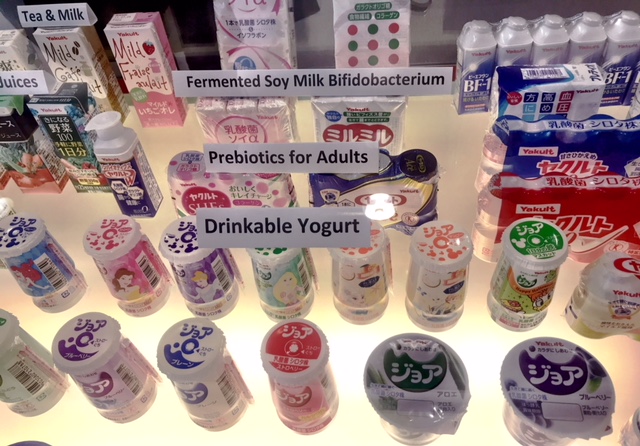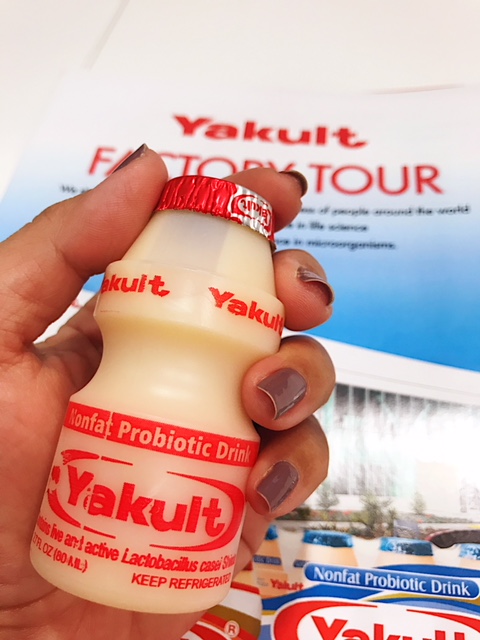
While strolling Natural Products Expo West in March, we came across a familiar booth. Although we had tried the mini bottles of tart probiotics before, what we were shocked to learn was that Yakult’s U.S. manufacturing facility was based out of Fountain Valley. Better yet, they offered free tours! So we signed our life away, placed the visitor lanyard around our neck, and followed Frank as he guided us through an hour of education. The tour included a discussion on all displays, viewing commercials from around the world, a slideshow discussing bacteria and the Yakult philosophy (a feature cartoon), and a walk down a very long corridor, showing all the steps in the manufacturing process.
1 – Built in 2014, the original headquarters was founded in 1955 over in Tokyo. The Fountain Valley facility manufactures for the US as well as Canada. However, they are currently predominant on the West Coast and New England states.
2 – If you’ve ever caught an Angels game, you may have spotted a Yakult table in an uncovered part of the stadium. That’s because they have a sponsorship with the Angels. They hand out free samples before each game; and we say before, because Yakult tends to run out by the first pitch.
3 – The name Yakult originates from the universal language of Esperanto. Its translation is yogurt, even though it isn’t really yogurt. Yakult is actually a fermented, skimmed milk drink.
4 – Why the tiny size? Bottle size and design are determined by country. Some countries have slightly larger sizes, but they also have say in what goes into the formulas. Some add other vitamins or nutrients.

5 – While we’re on the subject of bottles, they’re also manufactured in-house. Their original material used to be glass, and they were even sold in shapes that look a lot like wine bottles. In the late 60s, they began using plastic pellets that are heated and shaped into test tubes. Then the tubes are formed into the familiar bottle shape; that shape was created by a furniture designer.
6 – Yakult’s mascot is named Ken. Yes, Ken. We’re told that in Japanese, it has a different meaning. We did find that in Japan, it’s spelled Yak-kun, so there’s that.
7 – One 2.7 ounce bottle of Yakult per day is sufficient for your body. Why? Well, it already contains roughly 8 billion of their exclusive probiotic strain, Lactobacillus casei Shirota, per bottle. That’s enough to help all that goes on inside your belly. When they introduced the Light version in 2012, it contained 20 calories less and was sweetened with Stevia. It’s also best to refrigerate within 15 minutes of removing it from the shelf, to receive the maximum benefit.
8 – Rewinding to go over the probiotic, Lactobacillus casei Shirota: Lacto = Milk; Bacillus = small rod (a.k.a. rod-shaped bacteria); casei = discovered in cheese; Shirota = discovered by Dr. Shirota.
9 – During the quality control portion of our factory tour, we learn that a sample of Yakult-in-process is sent to the lab and carefully checked. Our group looked right into the space while a few scientists were still hard at work on a Friday afternoon. Turns out there are more female microbiologists that work there than male.
10 – Yakult does much more than probiotic drinks. They have a skin care line, do cancer research, and many other beverage options in addition to what we know them for.
11 – We were schooled on how to correctly open a bottle of Yakult. It looks so easy, but sometimes it’s tough to get the foil lid to peel off in one try. The secret: lifting the seal around all edges along the perimeter beforehand. When it’s time to open, it comes right off. Easy peasy. You can see a visual aid in our Instagram Highlights.
Learn more about Yakult at www.yakultusa.com.
A contributing writer for OC Weekly, Anne Marie freelances for multiple online and print publications, and guest judges for culinary competitions. A Bay Area transplant, she graduated with a degree in Hospitality Management from Cal Poly Pomona. Find her on Instagram as brekkiefan.

